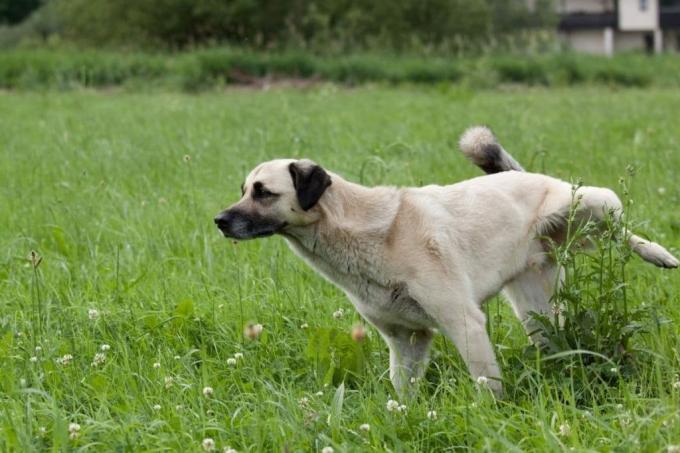
table of contents
- Dryness and wetness
- Mistakes in fertilizing
- Unfavorable soil pH
- Mowing error
- Dog urine makes the lawn yellow
- Lawn diseases
- frequently asked Questions
A full green one race is the pride of many hobby gardeners. But when it gets warmer outside, yellow spots can be seen in the lawn in many places. They can have different causes.
In a nutshell
- yellow patches of lawn are often the result of incorrect maintenance
- The main causes are drought, errors in fertilization and pruning
- Dogs can also be the cause of unsightly spots
- Targeted measures promote self-healing of the lawn
- targeted reseeding is sometimes necessary
Dryness and wetness
Persistent drought and temperatures above 30 degrees Celsius can affect lawn grasses. They turn yellow and die.

- Degree of damage depends on the duration of drought, root penetration and cutting height
- natural rainfall is often insufficient
- First remove the cuttings in order to save them
- provides sufficient light and air for regeneration
- then water and apply fertilizer
- does it not help to re-sow the lawn
- in the case of more serious damage caused by drought, apply a completely new one
Overwatering can also affect lawn grasses. It does not grow and shows yellow discoloration. Then give the floor time to recover. The soil moisture is tested and watered only very cautiously at first. Ideally, it is ten to fifteen centimeters deep moistened.
Mistakes in fertilizing
Overfertilization
A common problem is the incorrect use of fertilizer. When there is an oversupply of nutrients, the lawn can hardly absorb nutrients, it does not grow and turns yellow in places. If there is overfertilization, excess nutrients can be flushed out of the soil through thorough watering over several days. The fertilizer concentration decreases, the Grasses can recover.

Tip: Regardless of the type of fertilizer, you should follow the manufacturer's dosage recommendations.
Wrong fertilizer
Lawn grasses need a very specific nutrient composition. The most important nutrients are nitrogen, phosphorus and potassium. Nitrogen promotes leaf growth and the formation of chlorophyll and phosphorus promotes root formation. Potassium makes them more resistant to disease.
Good lawn fertilizers contain exactly these substances in the right proportions. Ideally, organic fertilizers are used instead of mineral ones. They are free of chemical and mineral substances, which also protects the environment. The fertilizing effect starts a little more slowly, but is available in the soil for a longer period of time.
Unfavorable soil pH
Yellow patches of lawn are not always the result of incorrect maintenance. Often it is due to the subsurface. Even the best home remedies cannot do anything here.

- The pH value of the soil is one of the decisive factors for the quality of the lawn
- acidic pH is particularly problematic
- affects the growth and health of the grass
- Value ideally between 5.5 and 6.5
- pH below 5.5 is acidic
- Increase the value to the ideal level by liming
- previous scarifying allows lime to act better
It can take some time before the first successes are visible. The pH value can be easily determined with appropriate tests from the hardware store.
Tip: For a more precise soil analysis, you can also have your soil samples evaluated in a specialist agricultural laboratory.
Mowing error
Mowed too early
After a long winter, the grasses are chipped by cold temperatures and snow that has been lying on them for a long time. Now you should give them time to recharge their batteries and get used to the warmer temperatures.
If this process is prevented by mowing too early, the result may be yellow discolouration and the grass will not grow. In spite of everything, leaves, dead or sticky grasses should be removed with a rake in early spring. The first cut should be made as soon as the grass has reached twice the height of the desired cutting height, around April.

Tip: Fallen leaves should be removed as early as autumn if possible. Because even in winter, lawns need a minimum of light.
Cut too deep
Often the lawn is cut too short. Then there is a risk of sunburn, which in turn causes the grass to turn yellow.
- the shorter the lawn, the more sensitive the grasses
- first mowing at the beginning of the growing season
- leave one to two centimeters longer than normal at first
- In general, never cut lawn grass by more than half
- From the third mowing process, cut down to the usual height
- Recommended cutting length between 3.5 and 5 cm
- in dry conditions no more than four centimeters
- Lawn in shady locations should never be shorter than five centimeters
Dog urine makes the lawn yellow
It is not uncommon for dog urine to be responsible for discoloration in lawns. Tagging dogs is very natural. However, if this happens on the lawn, it is particularly annoying. What you can do about it is keep an eye on the dog. As soon as he urinates, rinse the affected area with copious amounts of water to prevent the grasses from dying off. Home remedies aren't particularly helpful here either. In the case of older stains, only reseeding usually helps after dead plant material has been removed.

Lawn diseases
Red tipped (Laetisaria fuciformis)
Red tipped is characterized by irregular, interlocking yellowish spots. An infection can occur all year round at temperatures between 15 and 22 degrees with a lot of moisture and a lack of nutrients, most often in summer. A pink fungal network can be seen in the leaf tips. The disease can usually be treated well by adding fertilizer. It is mainly about nitrogen.
This contributes to the fact that the grasses really outgrow the disease. You calculate four to six grams of nitrogen per square meter. A few days after fertilization, there is usually not much to see of the fungus. Infested grasses sprout again. The use of fungicides is not required. As a preventive measure, regular mowing, balanced fertilization and watering should take place.

Leaf spot disease
Persistent moisture, one-sided fertilization and grass clippings that are too deep weaken the grass. The lawn does not grow, turns yellow, and is prone to leaf spot disease. It can occur from spring to autumn, favored by temperatures between 10 and 30 degrees. Signs of an infestation are whitish-yellow to brownish spots. To combat it, scarify the soil, ensure adequate ventilation, fertilize as required and avoid dryness and wetness.
Dollar blotch disease
The dollar spot disease mostly occurs in the summer months at temperatures above 25 degrees and cool nights with dew formation. It manifests itself in sharply demarcated, light spots. Over time, they can grow to more than 10 cm. Balanced fertilization and irrigation are necessary remedial measures. In addition, good soil permeability must be ensured and drought stress must be avoided.
frequently asked Questions
If fertilization is stopped completely, the grasses not only suffer from an excess of nutrients, but also from a lack of nutrients. Continuing to fertilize normally can exacerbate the effects of overfertilization. Only a soil analysis can provide clarity as to whether and how fertilization should be carried out in the future.
The cause is often the use of mineral fertilizers. Over-fertilization is not possible with organic fertilizers such as compost, horn shavings or humus. As a result, the use of organic fertilizers is generally recommended.
The months of September and October are ideal for reseeding. The soil is still warm and precipitation is increasing again. When it comes to seeds, you should definitely pay attention to good quality.



